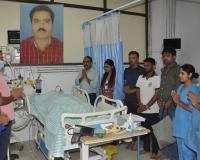Khammamwati Stepwell: Surat’s 600-Year-Old Testament to Water Heritage and Community Spirit

Surat, nestled along the banks of the river Tapi, is a city rich in history and culture. Amid its bustling urban landscape stands a lesser-known but architecturally magnificent water monument—the Khammamwati Stepwell. Located in the Lal Darwaja area, this ancient marvel is also known as "Ba No Banglo" and "Vanajari Vav," names that echo centuries of local tradition and reverence.
Believed to be nearly 600 years old, the seven-storeyed stepwell is a stunning example of India’s historic water conservation architecture. Built in the medieval Nanda style during the Mughal era, the stepwell is attributed to Lakha Vanjara, a prominent trader of his time who owned a caravan of one lakh bullocks. These Vanjaras were influential merchants who traversed the country, and wherever they went, they left behind community assets such as stepwells, temples, and inns for the welfare of society.
The Khammamwati Stepwell is approximately 300 feet in length and 20 feet in width, featuring a single entrance and over 100 steps descending into the earth. Constructed using sandstones and thick bricks, its south-facing orientation adheres to principles of Indian craftsmanship. Positioned close to the old city fort walls, the stepwell plunges deep into history, evoking a sense that it is more than just a water source—it is a living relic of the past.
The site also houses a small temple dedicated to Khammamwati Mata, making it a spiritual hub for the local community. For generations, it has been believed that the water from the stepwell possesses healing properties, especially for skin ailments, colds, and bone-related conditions.
Remarkably, during the devastating flood of 2006 that inundated large parts of Surat, the Khammamwati Stepwell continued to serve its original purpose—it absorbed excess water, acting as a natural reservoir that silently protected the city even centuries after its construction.
Located in Chhovala Gali near Lal Darwaja, the stepwell is surrounded by historical residences such as Killa Seth ni Wadi and Chhagan Seth Wadi. Many descendants of the original Vanjara families still reside in this area, where the stepwell is not merely an architectural structure but a cherished symbol of faith, community, and resilience.
According to Neel Patel, a descendant of the Killa Seth family, people from across the city once gathered here to celebrate festivals like Garba, and the waters of the Khammamwati Vav have never dried up. Its enduring presence serves as a reminder of sustainable living and community-centered development long before such terms were coined.
Notable features of the stepwell include its medieval origin in the 15th century, its construction in Nanda architectural style, and its robust build of sandstone and thick bricks. It remains a site of spiritual importance due to the temple of Khammamwati Mata within its structure and is revered as a natural remedy for various ailments.
More than just an architectural relic, the Khammamwati Stepwell is a vital part of Surat’s identity—a symbol of water conservation, cultural memory, and spiritual devotion. Preserving it for future generations is not only a responsibility but a tribute to the foresight of those like Lakha Vanjara, whose legacy continues to nourish the city today.






